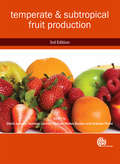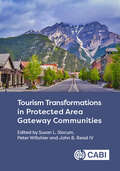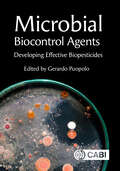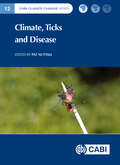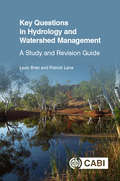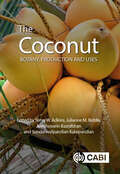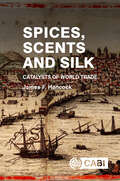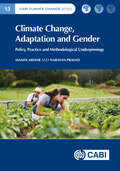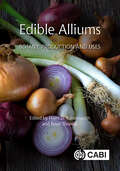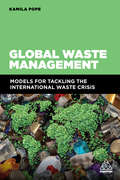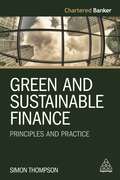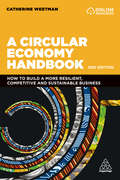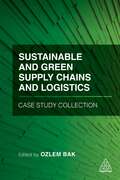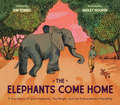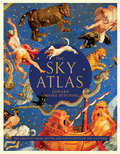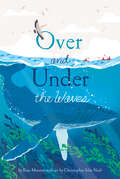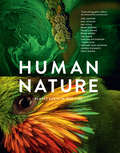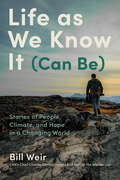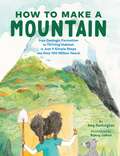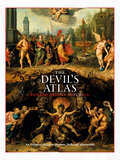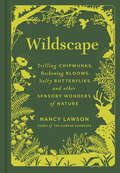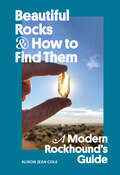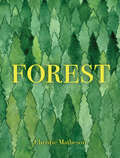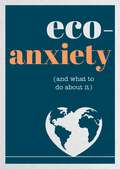- Table View
- List View
Temperate and Subtropical Fruit Production
by David Penman R Chapman Peter Lyford William Atkinson Roy Edwards John Palmer David McNeilFully revised and expanded to include organic fruit production, this new edition provides a thorough introduction to the cultivation of fruit found throughout the temperate and subtropical regions of the world.
Tourism Transformations in Protected Area Gateway Communities
by Dorothee Bohn Andrea Zita Botelho Kelly S. Bricker Robert S. Bristow Karina H. Casimiro Rosa Suárez Chaparro Ana Cristina Costa Kynda R. Curtis Margaret J. Daniels Edieser Dela Santa C. Michael Hall Manuel Ramón Herrera Russell M. Hicks Julie Judkins N. Qwynne Lackey Natalya Lawrence Gustavo C. Machado Gianna Moscardo Jake Powell Sidnei Raimundo Mary Anne Ramos-Tumanan Milena Manhães Rodrigues Professor Chris Ryan Renato De Santos Jessica A. Schottanes Ole R. Sleipness Maria Anunciação Ventura Therez B. WalkerGateway communities that neighbour parks and protected areas are impacted by tourism, while facing unique circumstances related to protected area management. Economic dependency remains a serious challenge for these communities, especially in a climate of neoliberalism, top-down policy environments, and park closures related to environmental degradation or government budgets. The collection of works in this edited book provide bottom-up, informed, and nuanced approaches to tourism management using local experiences from gateway communities and protected areas management emerging from a decade of guidelines, rulemaking, and exclusive decision-making. Global perspectives are presented and contextualized at the local level of gateway communities in an attempt to balance nature, community, and commerce, while supporting the triple bottom line of sustainable tourism. While anticipating a post-COVID 19 global shift, readers are encouraged to think through transformation and resiliency in regard to how the flux of supply vs demand alters gateway community perspectives on tourism. Specific features of this book include: · Focus on transformations, which provides insight into the complex and dynamic nature of gateway communities. · Multidisciplinary, multi-cultural insights into protected area management. · Applied and conceptual chapters from global perspectives.
Microbial Biocontrol Agents: Developing Effective Biopesticides
by Abhishek Anand Marc Bardin Ana Bejarano Elisa Bona Tito Caffi Hamza Chammem Antonieta De Cal Margherita Furiosi Elisa Gamalero Bernard R. Glick Belén Guijarro Lars Huber Dr Ajay Kumar Inmaculada Larena Sara E. Legler Carla S. Lorenz Paloma Melgarejo Hassan Momeni Fahimeh Nazari Andrea Nesler Philippe Nicot Ma. del Orozco-Mosquedab Ilaria Pertot Thomas Pressecq Dr Gerardo Puopolo Vittorio Rossi Naser Safaie Gustavo Santoyo Selena Tomada Estelle Turc Maria Villarino Mout De Vrieze Laure WeisskopfThe negative impact of chemical pesticides on human wellbeing and the environment has encouraged the development of eco-friendly alternatives for the management of plant pathogens. However, only a small number of microbial biocontrol agents (mBCAs) have been developed, registered and used in the management of plant diseases. This book analyses the deployment of mBCAs for the development of novel microbial biopesticides, considering the main plant-beneficial traits, procedures needed for effective formulations and the processes used for their validation. To guide the readers through the world of microbial biopesticides, the book starts with a chapter dedicated to the regulations that need to be followed for the development of final products. Readers will understand the importance of formulation and mode of action of mBCAs in developing microbial biopesticides. They will become familiar with key mBCAs such as Ampelomyces quisqualis, Bacillus spp., Trichoderma spp., and Pseudomonas spp., understanding the importance of formulation for their application in the field. This book explains the use of mBCAs to control post-harvest diseases and the potential of endophytic microorganisms as next-generation microbial biopesticides. A final chapter provides a useful workflow for the selection of new mBCAs and describes microbial species including promising mBCAs that might be developed as new microbial biopesticides. - Gives useful insights into the practicalities of regulation of mBCAs - Describes the underlying biology that it is critical to developing mBCAs - Provides case studies for key mBCA species - Indicates microbial species exploitable for the development of new microbial biopesticides For students and researchers involved in crop protection and biological control
Climate, Ticks and Disease (CABI Climate Change Series #18)
by Saeed Alasmari Neil Alexander Abdelghafar Alkishe Reiko Arai Armanda Bastos Gervasio Henrique Bechara John Beier Giovanni Benelli Joshua Benoit Dennis Bente Richard Bishop Adrien Blisnick René Bødker Fernando Boinas Sarah Bonnet Nathalie Boulanger Alejandro Cabezas-Cruz Alexandre Rodrigues Caetano Cyril Caminade Jirí Cerny´ Roxanne Albertha Charles Ali Reza Chavshin Rosalind Cornforth Neil Coughlan Peter Cox Lauren Culler Milan Daniel Vlasta Danielova Mona Dehhaghi Maria Diuk-Wasser James P Duffy Olivier Duron Lars Eisen Rebecca Eisen Jana Elsterová Koray Ergünay Agustín Estrada-Peña Li-Qun Fang Natalia Fernández-Ruiz Erol Fikrig Serhii Filatov Durland Fish Janet Foley José De Fuente Roman Ganta Aysen Gargili Keles Robin Beat Gasser Abdul Ghafar Naftaly Githaka Lucy Gilbert Maryna Golovchenko Yuval Gottlieb Ernest Gould Jeremy Gray Libor Grubhoffer Gilles J. Guillemin Kayleigh M. Hansford Charles Hart John E. Healy Deborah Hemming Stephen Higgs Andrew Hoodless Yan-Jang S. Huang Bernard Hudson Chris Huntingford Peter Irwin Abdul Jabbar Nicholas Johnson Esther Kanduma Sirri Kar Maria Kazimirova Neil Kaye Thomas C. Kelly Lene Jung Kjaer Agatha Onyemowo Kolo Eduard Korenberg Nina Król Chi-Chien Kuo Timothy J. Kurtti Xavier De Lamballerie Patrick A. Leighton Hao Li L. Robbin Lindsay Wei Liu Geoffrey E. Lynn Ilya Maclean Ben J. Mans Maristela Martins de Camargo Karen D. McCoy Jolyon M. Medlock Ulrike G. Munderloh Atle Mysterud Sukanya Narasimhan Anna Obiegala Dasiel Obregón Alvarez Dr Nick H. Ogden Mari H. Ogihara Stefan Vilges Oliveira Charlotte Oskam Domenico Otranto Kennan J. Oyen Neha Pandey Hamed Kazemi Panahi A. Townsend Peterson John H. Pettersson Martin Pfeffer L. Paul Phipps Heather J. Plumpton Tatjana Pustahija Ram Raghavan Ryan O.M Rego Annapaola Rizzoli Isobel Ronai Franz Rubel Natalie Rudenko Benjamin Ruiwen Rufus Sage Abdallah M. Samy Gustavo Seron Sanches Isabel Kinney Santos Marcello Otake Sato Megumi Sato Richard Schloeffel Seyyed Javad Seyyed-Zadeh Ladislav Šimo Sunit Kumar Singh Daniel E. Sonenshine Morgan Sparey Frederic Stachurski Snorre Stuen Matias Pablo Szabó DeMar Taylor Mike Teglas Sam R. III Saravanan Thangamani Georgia Titcomb Attila J. Trájer Michael Turell Rika Umemiya-Shirafuji Dana L. Vanlandingham Laurence Vial Margarita Villar Richard Wall André B. Wilke G. R. Wint Jianhong Wu Zbigniew Zajac Xue ZhangThis book brings together expert opinions from scientists to consider the evidence for climate change and its impacts on ticks and tick-borne infections. It considers what is meant by 'climate change', how effective climate models are in relation to ecosystems, and provides predictions for changes in climate at global, regional and local scales relevant for ticks and tick-borne infections. It examines changes to tick distribution and the evidence that climate change is responsible. The effect of climate on the physiology and behaviour of ticks is stressed, including potentially critical impacts on the tick microbiome. Given that the notoriety of ticks derives from pathogens they transmit, the book considers whether changes in climate affect vector capacity. Ticks transmit a remarkable range of micro- and macro-parasites many of which are pathogens of humans and domesticated animals. The intimacy between a tick-borne agent and a tick vector means that any impacts of climate on a tick vector will impact tick-borne pathogens. Most obviously, such impacts will be apparent as changes in disease incidence and prevalence. The evidence that climate change is affecting diseases caused by tick-borne pathogens is considered, along with the potential to make robust predictions of future events. This book contains: Expert opinions and predictions. Global coverage of trends in ticks and disease. In-depth examination of climate change and tick distribution links. This book is suitable for researchers and students studying zoology, biological sciences, medical entomology, animal health, veterinary medicine, epidemiology, parasitology, and climate change impacts; and for those concerned with public health planning or livestock management where ticks and tick-borne pathogens pose a threat.
Key Questions in Hydrology and Watershed Management: A Study and Revision Guide (Key Questions)
by Professor Leon Bren Professor Patrick LaneThis book provides a series of exercises of various types covering matters of hydrology and watershed management. The exercises include true/false questions, multiple choice questions, and numeric, graphical, and analytical exercises. The questions draw on the basic disciplines of hydrology and physics, with some stress placed on correct or appropriate units. The questions reflect the authors' many years of teaching watershed management at undergraduate and graduate levels. Questions cover: 1. Terminology and measurement of flow (and units) 2. Quantifying stream networks 3. Concepts of water balance and evapotranspiration 4. Slope recharge, groundwater hydrology, and water-table/phreatic aquifers 5. Single and paired watershed experiments 6. Impacts of fires on watersheds 7. Concepts and measurements of water quality 8. Flooding forests 9. Valuation of water 10. Protection of forest stream by buffers 11. Urban watershed concepts The book is self-contained, and designed to be used at any time in any place, either for revision or as source material for teaching. The work is graded so that easier questions are presented early, followed by harder questions. Answers are concise but contain enough information to help students study and revise on a topic-by-topic basis. The book concludes with suggestions for student exercises and projects and is an invaluable resource for both students and instructors.
The Coconut: Botany, Production and Uses (Botany, Production and Uses)
by E. A. Aguilar J. Alouw F. C. Beveridge M. A. Bezerra R. Bhat R. Cave K. Chapman R. Dakshayani F. M. Dayrit P. D. Dissanayake H. R. Gheyi K. B. Hebbar V. B. Johnson Sundaravelpandian Kalaipandian S. Karouw A. C. Khanashyam E.Y.Y. Kong C.F.D. Lacerda J. C. Lacsina M. R. Manikantan E. C. Manohar Z. Mu M. Narváez M. F. Neto Q. T. Nguyen C. Oropeza C. F. Ortiz R. Pandiselvam B. Panis A. Peña L. Perera S. Periasamy S. Rajkumar M. Ramaswamy S. V. Ramesh E. Ramos N. Satyaseelan C. Silverio S. Sisunandar P. Subramanian P. A. Sukumar R. S. Veluchamy V.R.M. Vidhanaarachchi H. Wilms C. YangThe coconut palm (Cocos nucifera L.) is one of the world's most important palms, and contributes significantly to the income and livelihood of many people in tropical countries. Widely referred to as the 'tree of life', coconut has been used as a source of food, drink, oil, medicine, shelter and wood for around 500 years. Every part of the coconut palm can be utilized. The demand for coconut fruit and its products has increased recently as people have become aware of its nutritional and health benefits, especially those of coconut water and virgin coconut oil. This book covers all aspects of coconut including origins and diversity; ecophysiology; production in a changing climate; pests and diseases; harvest and postharvest management; breeding and genetics; as well as the current and future status of coconut as an economic crop. This book is a key resource for researchers and students in horticulture, plant science and agriculture, and those interested in the production of tropical crops, and practitioners in the coconut industry.
Spices, Scents and Silk: Catalysts of World Trade
by James HancockSpices, scents and silks were at the centre of world trade for millennia. Exotic luxuries such as cinnamon, ginger, pepper, saffron, clove, frankincense and myrrh. Through their international trade, humans were pushed to explore and then travel to the far corners of the earth. Almost from their inception, the earliest great civilizations - Egypt, Sumer and Harappa - became addicted to the luxury products of far-off lands and established long-reaching trade networks. Over time, great powers fought mightily for the kingdoms where silk, spices and scents were produced. The New World was accidentally discovered by Columbus in his quest for spices. What made trade in these products so remarkable was that the plants producing them grew in very restricted areas of the world, distant from the wealthy civilizations of northern Africa, Greece and Europe. These luxuries could be carried from mysterious locations on the backs of camels or in the holds of ships for months on end, and arrived at their final destination in nearly perfect condition. Once the western world discovered the intoxicating properties of these products, their procurement became a dominant force in the world economy. Nothing else compared with their possible profit returns. In this book, eminent horticulturist and author James Hancock examines the origins and early domestication and culture of spices, scents and silks and the central role they played in the lives of the ancients. The book also traces the development of the great international trade networks and explores how struggles for trade dominance and demand for such luxuries shaped the world. Recommended for academics, students and general readers with an interest in crop and agricultural development, world trade, economic botany, history of food, and global economics and public policy, Spices, Scents and Silk offers a fascinating and insightful history.
Climate Change, Adaptation and Gender: Policy, Practice and Methodological Underpinnings (CABI Climate Change Series #17)
by Dr Mamta Mehar Professor Narayan PrasadThis book offers a wide, in-depth study of the gender-climate change-agriculture nexus. The crux of understanding these connections comprises gender equality and tools to measure gender discrimination, the evolution of the concept of gender inclusiveness and its concerns; and the need to address the same by formulating gender-inclusive policymaking. Despite the fact that more than 50 years have elapsed since gender concerns were included in explorations of this nexus, there is still ambiguity around the foundations, connections, and approaches for planning gender-inclusive climate policies. This book aims to clear that ambiguity by: · Being the first to explore exclusively this issue in detail. · Revealing how and why consideration of gender is so important for understanding how climate change impacts rural communities and agricultural systems globally. · Exploring every dimension of climate change (including belief systems and perceptions, knowledge, experience, coping strategies, adaptation, and mitigation strategies) and linking it to gender. It includes new theoretical and methodological approaches that go far beyond the household as the unit of analysis (using various approaches, including intersectional analysis). The book not only throws light on major themes of research, but also covers different methodologies ranging from review methods to mathematical models, conceptual frameworks and empirical analysis. It will be of wide interest to students, scholars, and researchers in gender studies, agriculture, climate change and rural development research, and also to practitioners, extension workers, and planners designing new climate-resilient practices.
Edible Alliums: Botany, Production and Uses (Botany, Production and Uses)
by Haim D. Rabinowitch Brian ThomasAllium crops include more than 30 species, many of which (for e.g. onions, shallots, garlic, leeks, bunching onions, and chives) are of economic importance. Bulb onions rank second only to tomatoes in terms of global production. Alliums are farmed and harvested in a range of climatic conditions worldwide, forming important parts of local diets. This book provides a comprehensive review of major and minor Allium crops from scientific and horticultural perspectives. It broadly covers modern biology (including genetics and breeding), propagation, production, processing, and nutritional and health benefits. Edible Alliums contains coverage of: Both major and minor Allium crops. Improving crop production, quality, and sustainability of Allium crops. Advances in digital technologies, 'omics' research and gene editing. Objectives for improving crop performance, such as integrated crop management, the plant-soil interface, improving propagation materials, post-harvest quality and reducing waste. This is an essential resource for scholars, researchers and students in plant science and agriculture, in addition to molecular biologists, plant breeders, agronomists, consultants, and extension specialists.
Global Waste Management: Models for Tackling the International Waste Crisis
by Kamila PopeAmong other factors, rapid global population growth, our development model and patterns of production and consumption have increased waste generation worldwide to unsustainable rates. This rise has led to crises in many countries where waste management practices are no longer sound. Global Waste Management outlines the emerging global waste crisis considering the perspectives of developed and developing countries around the world and the international relationships between them. This book provides an ecological viewpoint as well as studying these problems from a legal and justice standpoint. Global Waste Management contextualises the problems faced when dealing with waste including the causes and origins. Focus is given to cross border waste transfer, as an ongoing and controversial practice, making waste management a global matter. This book scrutinizes existing international, European and Brazilian regulation on waste to highlight the complexity of the subject and the weaknesses of the law. Using a critical and socio-ecological approach, the book proposes an original model of governance to support a new system of global waste management that takes into account ecological sustainability and social justice to overcome the waste crisis. To create these models, a theoretical framework on socio-ecological justice is developed and combined with different discourses and theories described throughout the book. This is the essential guide to understanding the global waste crisis and the future of waste management.
Green and Sustainable Finance: Principles and Practice (Chartered Banker Series #6)
by Simon ThompsonMore than 120 countries have committed to net zero targets by 2050, requiring systemic economic transitions on an unprecedented scale and with the finance sector playing a leading role. Green finance will power the transition, ensuring capital flows to the firms, investments, projects and technologies looking to create a sustainable, low-carbon world. To achieve net zero, every professional financial decision must take climate change and broader sustainability factors into account. Green and Sustainable Finance provides a comprehensive guide to the application of common green and sustainable principles and practices in banking, investment and insurance to help finance professionals embed these in their daily activities and decision-making. Focusing on the necessity of mainstreaming green and sustainable finance globally, this book includes a clear explanation of the science underpinning climate change. Green and Sustainable Finance covers a wide range of green finance products and services in retail, commercial and corporate banking, insurance, investment and fintech. It provides an overview of emerging regulation and international market frameworks and standards, particularly in relation to climate and environmental risk. Consideration is also given to the ethical dimensions of green and sustainable finance, including how professionals can promote market integrity and take active steps to avoid greenwashing. Endorsed by the Chartered Banker Institute as the core text for the benchmark Certificate in Green and Sustainable Finance, this book is essential reading for finance professionals and students, and individuals working to embed sustainability in business, policy and regulation.
A Circular Economy Handbook: How to Build a More Resilient, Competitive and Sustainable Business
by Catherine WeetmanWINNER: 2018 Les Plumes des Achats & Supply Chain - The Committee Special Prize As we learn more about the climate and biodiversity crisis, it is clear that how we make and consume things is a major part of the problem. Extraction and processing of materials, fuels and food makes up about half of global greenhouse gas emissions and over 90% of biodiversity loss and water stress. Many modern businesses deplete resources, destroy ecosystems and dump waste and pollution at every stage - harming human health along the way. Governments, businesses and think-tanks see the circular economy as the way forward. Now in its second edition, A Circular Economy Handbook is a guided tour through the concepts and the practicalities. A unique framework systematically explores the range of circular interventions, including product and supply chain design, material choice and supporting business models. How does it really work for business? What circular approaches are emerging in food, fashion, consumer technology, packaging and other sectors? How do these reduce risk, improve resilience and build profitable, future-fit organizations? With over 300 real examples from around the world, this is a must-read for businesses, students and policymakers. This new edition has been extensively updated to include the latest trends, thinking, research and solutions, with a new chapter on packaging and 30 new company snapshots.
Sustainable and Green Supply Chains and Logistics Case Study Collection
by Dr Ozlem BakSustainability is an increasingly urgent and important factor in logistics and supply chain management, impacting the whole supply chain lifecycle from product design and development, to supplier management, packaging, transportation, warehousing and distribution.The third volume of the Supply Chain Case Study Collection, the Sustainable and Green Supply Chains and Logistics Case Study Collection contains real-life scenarios from leading companies who are pursuing a sustainability agenda. Cases cover sustainability and 'green' practices in a range of different industries, from food through to manufacturing and construction, and in a variety of organization sizes. They are written by leading international academics and feature cutting-edge research from countries including India, Vietnam, Brazil, China and the UK. By exploring examples of waste reduction, supplier management, the circular economy and cross-industry collaboration, the Case Study Collection focuses on how organizations are currently trying to meet sustainability goals and achieve success in greening supply chains.
The Elephants Come Home: A True Story of Seven Elephants, Two People, and One Extraordinary Friendship
by Kim TomsicThe amazing true story of a herd of elephants, the man who saved them, and the miracle of love that brought them home.One day in 1999, Lawrence Anthony and Françoise Malby hear that a herd of wild African elephants need a new home. They welcome the elephants to their wildlife sanctuary—Thula Thula—with open arms. But the elephants are much less sure they want to stay. How will Lawrence prove to them that they are safe and loved? What follows is a gorgeously illustrated real-life story of a friendship . . . and the story of the miraculous way that love given freely will return—greater and more wonderful than it began.• TOUCHING ANIMAL FRIENDSHIPS: Owen and Mzee, Tarra and Bella, Rescue and Jessica . . . touching true stories of the emotional bonds possible between species are charming, and speak to the limitlessness of love.• ELEPHANT APPEAL: Elephants are one of the most fascinating and charming wild animals in all of nature. This heartwarming true story will intrigue and inspire children, and turn even the most reluctant readers into elephant enthusiasts.• CONSERVATION THEME: This book tells the true story of caring for one of the world's most beloved endangered animals: the African elephant. This book is a great, upbeat jumping-off point for discussions of the importance of preserving endangered species and their environments.• ENGAGING NONFICTION: There's no better way to get readers hooked on factual books than to offer them real-life stories with heart and meaning.• STRONG CURRICULUM CONNECTIONS: The Next Generation Science Standards (NGSS) emphasize learning about animal habitats/biomes in K–2 curriculums, while later grades address topics like conservation and endangered species. With a depth of research and an engaging, highly visual narrative, this book is an excellent resource for librarians and primary school educators.Perfect for:• Kindergarten and elementary school teachers• Parents and grandparents• Librarians• Lovers of animals, wildlife, and the natural world• Zoo and natural history museumgoers
The Sky Atlas: The Greatest Maps, Myths, and Discoveries of the Universe
by Edward Brooke-HitchingThe Sky Atlas unveils some of the most beautiful maps and charts ever created during humankind's quest to map the skies above us. This richly illustrated treasury showcases the finest examples of celestial cartography—a glorious art often overlooked by modern map books—as well as medieval manuscripts, masterpiece paintings, ancient star catalogs, antique instruments, and other curiosities. This is the sky as it has never been presented before: the realm of stars and planets, but also of gods, devils, weather wizards, flying sailors, ancient aliens, mythological animals, and rampaging spirits. • Packed with celestial maps, illustrations, and stories of places, people, and creatures that different cultures throughout history have observed or imagined in the heavens• Readers are taken on a tour of star-obsessed cultures around the world, learning about Tibetan sky burials, star-covered Inuit dancing coats, Mongolian astral prophets and Sir William Herschel's 1781 discovery of Uranus, the first planet to be found since antiquity.• A gorgeous book that delights stargazers and map lovers alikeWith thrilling stories and gorgeous artwork, this remarkable atlas explores our fascination with the sky across time and cultures to form an extraordinary chronicle of cosmic imagination and discovery.The Sky Atlas is a wonderful book for map lovers, history buffs, and stargazers, but also for those who are intrigued by the many wonderful and bizarre ways in which humans have sought to understand the cosmos and our place in it.• A unique map book that expands beyond the terrestrial and into the celestial• A wonderful book for map lovers, obscure-history fans, mythology buffs, and astrology and astronomy lovers• Great for those who enjoyed What We See in the Stars: An Illustrated Tour of the Night Sky by Kelsey Oseid, Maps by Aleksandra Mizielinska and Daniel Mizielinski, and Atlas of Remote Islands: Fifty Islands I Have Never Set Foot On and Never Will by Judith Schalansky
Over and Under the Waves
by Kate Messner Christopher Silas NealExplore the wonders and beauties of the ocean's kelp forests in this latest addition to the acclaimed Over and Under series. Award-winning duo Kate Messner and Christopher Silas Neal return in this latest addition to the Over and Under picture book series, this time exploring the rich, interconnected ecosystem of the ocean! Over the waves, the sea lions bark and seagulls wheel and call. The bay is smooth and bright in the sun. But under the waves, there's a whole hidden forest, full of whales and wolf eels, sardines and sea bass, leopard sharks and luminous jellies, as well as the waving kelp that shelters them all. Discover the magical depths of the kelp forest, and all the fascinating creatures living just a paddle's length away—over and under the waves. SO MANY FASCINATING FACTS: Kids are endlessly curious about the natural world and the wildly varied animals and plants living in it—and the ocean is FULL of amazing and surprising life! ENVIRONMENTAL AWARENESS MADE WONDERFUL: Preservation of our wilderness—and of our oceans in particular—is essential, and this book makes such a great, upbeat jumping-off point for discussions of the importance and wonder of our world's natural habitats and ecosystems. THE GORGEOUS UNDERWATER WORLD: This new book in the Over and Under series illuminates the magic and amazing biodiversity of the kelp forest by telling the story of one family's kayaking trip through a real-world ocean ecosystem. Lyrical prose and color-drenched illustrations will draw even the most reluctant readers into the world. STRONG CURRICULUM CONNECTIONS: The Next Generation Science Standards (NGSS) emphasize learning about animal habitats/biomes in K-2 curriculums, while later grades address topics like food chains, conservation, and endangered species. With a depth of research and an engaging, highly visual narrative, this book is an excellent resource for librarians and primary school educators. FROM A FAVORITE AUTHOR-ILLUSTRATOR TEAM: Kate Messner and Chris Neal make nonfiction approachable and appealing! These two award-winning creators have received countless accolades and published books to critical acclaim, making them the perfect team to tackle any nonfiction topic. Perfect for:Those who loved Over and Under the Snow and other books in the Over and Under seriesFans of Kate MessnerLovers of the ocean and marine lifeParents and grandparents seeking beautiful books to read aloud togetherTeachers, educators, and librarians seeking illustrated nonfiction books with STEM contentAnyone seeking a distinctive gift for a child who loves animals or nature
Human Nature: Planet Earth In Our Time: Twelve Photographers Address the Future of the Environment
by Geoff Blackwell Ruth HobdayIn Human Nature, 12 of today's most influential nature and conservation photographers address the biggest environmental concerns of our time.• Joel Sartore• Paul Nicklen• Ami Vitale• Brent Stirton• Frans Lanting• Brian Skerry• Tim Laman• Cristina Mittermeier• J Henry Fair• Richard John Seymour• George Steinmetz• Steve WinterAlongside their reflections, they present curated selections from their photographic careers. Stories and extraordinary images from around the world come together in a powerful call to awareness and action.• The United Nations has declared that nature is in more trouble now than at any other time in human history.• Extinction looms over one million species of plants and animals.• Human Nature wrestles with challenging questions: What do we have? What do we stand to lose?This book offers inspiration to environmentalists, activists, photography fans, and anyone concerned about the future of our world.• This illuminating book tackles our modern environmental future through the lens of preeminent photographers• Great gift for photographers, nature enthusiasts, those who enjoy backpacking and camping, and anyone who cares about Earth's climate and future• Add it to the shelf with books like National Geographic The Photo Ark Vanishing: The World's Most Vulnerable Animals by Joel Sartore, The Sixth Extinction: An Unnatural History by Elizabeth Kolbert, and Dire Predictions: The Visual Guide to the Findings of the IPCC by Michael E. Mann and Lee R. Kump.
Life as We Know It (Can Be): Stories of People, Climate, and Hope in a Changing World
by Bill WeirAward-winning journalist and CNN chief climate correspondent Bill Weir draws on his years of immersive travel and reporting to share the best ideas and stories of hope and positivity from the people and communities around the world who are thriving in the wake of climate change, and what we can learn from them to build a more promising future.While reporting from every state and every continent, and filming his acclaimed CNN Original Series The Wonder List, Bill Weir has spent decades telling the stories of unique people, places, cultures, and creatures on the brink of change. As the first Chief Climate Correspondent in network news, he’s immersed in the latest science and breakthroughs on the topic, while often on the frontlines of disasters, natural and manmade.In 2020, Bill began distilling these experiences into a series of Earth Day letters for his then-newborn son to read in 2050, to help him better understand the world he will have grown up in and be better prepared to embrace the future. Bill’s work and his letters were the inspiration for Life As We Know It (Can Be), which confronts the worry and wonder of climate change with messages and examples of hope for all of us on how a better future can still be written.Highlighting groundbreaking innovation in fields of clean energy, food and water sources, housing and building materials, and more, and touching on how happiness, resilience, and health and wellness factor into the topic of climate change, Bill’s stories take readers on a global journey, from one community in Florida that took on a hurricane and never lost power, to the Antarctic Peninsula where one species of penguin is showing us the key to survival, to the nuclear fusion labs where scientists are trying to build a star in a box. In these pages, we join a search for ancient wisdom and new ideas.Life As We Know It (Can Be) is a celebration of the wonders of our planet, a meditation on the human wants and needs that drive it out of balance, and an inspiration for communities to galvanize around nature and each other as the very best way to best prepare and plan for what’s next.
How to Make a Mountain: In Just 9 Simple Steps and Only 100 Million Years!
by Amy HuntingtonGeology and earth science made easy (to learn) and super quick (to read about). You, too, can make a mountain—just grab this nonfiction picture book and start today!DO IT YOURSELF!START TODAY!From shaping peaks and crafting a glacier to nurturing your own plants and animals, these nine simple steps cover everything you need to know to make your very own mountain. In this book, you'll learn how to• Crush a piece of continent into a mountain range;• Freeze and melt glaciers;• Carve ravines, valleys, rivers, and mountain lakes;• Foster plants and develop a fertile layer of soil; and• Fill your mountain with a wide variety of animals that will work together to keep your mountain ecosystems healthyYES—YOU, TOO, CAN MAKE A MOUNTAIN!It is a big job, but it's also a thrilling adventure! Pack your snacks, load up your gear, and get ready for the challenge of a lifetime!*Tectonic plates, tools, and wildlife not included. Some restrictions apply. The authors assume no responsibility for frostbite, landslides, or accidental volcanoes.SCIENCE WITH A PLAYFUL, DIY TWIST: This fun and funny nonfiction picture book humorously encourages readers to get busy making their own mountain ranges. By the end, they will have learned the many steps that ultimately turn a rock into a peak, a slope into a gorge, snow into a glacier, and much more!GREAT FOR BUDDING ENVIRONTMENTALISTS: Once readers have "built" their mountains, their jobs aren't over—because the environment needs caretakers and stewards, of course! With rich back matter and lush illustrations accompanying an engaging text, this picture book is perfect for instilling a love of the natural world in budding scientists, environmental activists, and nature enthusiasts.STRONG CURRICULUM CONNECTIONS: Earth science is a staple classroom subject in all elementary school grades. With a depth of research and an engaging, highly visual narrative, this book is an excellent resource for librarians and primary school educators.Perfect for:• Teachers and librarians• Parents, grandparents, and caregivers• Anyone who loves or collects rocks• Lovers of fun, unique approaches to nonfiction and STEM topics• Gift-givers looking for a one-of-a-kind gift that's both funny and educational
River of Dust: The Life-Giving Link Between North Africa and the Amazon
by Jilanne HoffmannOver and Under the Rainforest meets This Is How We Do It in A River of Dust—a celebration of global interconnectedness with an environmental lens, at a time when we need it most.I am dust,the dust of North Africa.I connect continents. The dust of the Sahel—a ribbon of land between the Sahara and the savannah—lifts with the harmattan wind each winter season. But this is not just any dust. The Sahel's dust will mix with dust from the Sahara and travel thousands of miles westward, across the African continent and the Atlantic Ocean, to reunite with its unforgotten home deep in the Amazon basin. Told in the perspective of dust, A River of Dust takes readers on a journey through vibrantly illustrated landscapes, celebrating the power and wonder of Earth's ecosystems, and showing how these tiny particles are in fact key to the health of our planet. Meticulously researched and lushly illustrated, this picture book is a lyrical ode to global interconnectedness and the vital roles that even the smallest play in taking care of our planet.GLOBAL CONNECTIVITY: Just like This Is How We Do It, this book emphasizes global connectivity: the Amazon can't succeed by itself, and we all have a role to play.SMALL PARTICLES, MIGHTY IMPACT: This powerful story of the Sahel's very necessary contribution to the world demonstrates how seemingly inconsequential particles are key to the health of our planet. And if dust can be so important, readers will imagine the impact each one of them can have on the world around them.EDUCATIONAL TOOL: With strong STEM themes, this offers plenty of opportunities to incorporate into lesson plans, from units on geography and environmental science, particularly lessons on the rainforest, global warming, and interconnected ecosystems.SOOTHING LULLABY: Poetic and yearning, this picture book has a gentle message that reassures its readers about remaining connected despite time and distance with an affirmation of love that parents will enjoy sharing with their children.ARTFUL & LUSH: Vivid landscapes, from the deserts of Africa to the rainforests of the Amazon, by illustrator Eugenia Mello, make this lyrical picture book come to life. Note the gorgeous spattering of foil dust on the jacket, which makes this cover glow!WANT TO LEARN MORE?: Meticulously researched information included at the back of the book provides insight and compelling scientific facts for readers who are curious to know more. Did you know that there are more trees in the Amazon than stars in the Milky Way galaxy?Perfect for:Resource for teachers and librarians seeking books about nature, the earth, and ecology for kidsParents looking for non-fiction picture books and science books for childrenA beautiful environmental picture book and lyrical story for anyone interested in learning about ecosystems and the environmentFans of Over and Under the Rainforest, Over and Under the Pond, and other popular nature books for young readers
The Devil's Atlas: An Explorer's Guide to Heavens, Hells and Afterworlds
by Edward Brooke-HitchingPacked with strange stories and spectacular illustrations, The Devil's Atlas leads you on an adventure through the afterlife, exploring the supernatural worlds of global cultures to form a fascinating traveler's guide quite unlike any other. From the author of the critically acclaimed bestsellers The Phantom Atlas, The Sky Atlas, and The Madman's Library comes a unique and beautifully illustrated guide to the heavens, hells, and lands of the dead as imagined throughout history by cultures and religions around the world. Packed with colorful maps, paintings, and captivating stories, The Devil's Atlas is a compelling tour of the geography, history, and supernatural populations of the afterworlds of cultures around the globe. Whether it's the thirteen heavens of the Aztecs, the Chinese Taoist netherworld of "hungry ghosts," Islamic depictions of Paradise, or the mysteries of the Viking mirror world, each is conjured through astonishing images and a highly readable trove of surprising facts and narratives, stories of places you'd hope to go, and those you definitely would not. A traveler's guide to worlds unseen, here is a fascinating visual chronicle of our hopes, fears, and fantasies of what lies beyond. DISCOVER THE BEYOND: From the depths of underworlds to the heights of heavens and everywhere else a life after death may be spent, this atlas explores the geography, history, and supernatural populations of the afterworlds of global mythologies. A GLOBAL SURVEY: From the demon parliament of the ancient Maya, to the eternal globe-spanning quest to find the Earthly Paradise, to the "Hell of the Flaming Rooster" of Japanese Buddhist mythology (in which sinners are tormented by an enormous fire-breathing cockerel), The Devil's Atlas gathers together a wonderful variety of beliefs and representations of life after death. UNUSUAL AND UNSEEN: These afterworlds are illustrated with an unprecedented collection of images. They range from the marvelous "infernal cartography" of the European Renaissance artists attempting to map the structured Hell described by Dante and the decorative Islamic depictions of Paradise to the various efforts to map the Garden of Eden and the spiritual vision paintings of nineteenth-century mediums. EXPERT AUTHOR: Edward Brooke-Hitching is a master of taking visually–driven deep dives into unusual historical subjects, such as the maps of imaginary geography in The Phantom Atlas, ancient pathways through the stars in The Sky Atlas, and the literary oddities lining the metaphorical shelves of The Madman's Library. Perfect for:Obscure history and mythology enthusiastsAnyone with an interest in the occultSpiritual curiosity seekersMap lovers
Wildscape: Trilling Chipmunks, Beckoning Blooms, Salty Butterflies, and other Sensory Wonders of Nature
by Nancy LawsonFrom Nancy Lawson, author of The Humane Gardener, a first-of-its-kind guide that takes readers on an insightful and personal exploration of the secret lives of animals and plants.Master naturalist Nancy Lawson takes readers on a fascinating tour of the vibrant web of nature outside our back door—where animals and plants perceive and communicate using marvelous sensory abilities we are only beginning to understand. Organized into chapters investigating each of their five senses, Lawson's exploration reveals a remarkable world of interdependent creatures with amazing capabilitiesYou'll learn of ultrasound clicks humans can't hear, and ultraviolet colors humans can't see. You'll cross paths with foraging American bumblebees drawn to the scent of wild bergamot, urban sparrows who adapt their mating song in response to human clamor, trees that amp up their growth in response to deer and moose saliva, and a chipmunk behaving like the world's smallest pole vaulter to nab juicy red berries hanging from the lowest parts of a coral honeysuckle vine.Synthesizing cutting-edge scientific research, original interviews with animal and plant researchers, and poetic observations made in her own garden, Lawson shows us how to appreciate the natural environment from the sensory perspective of our wild neighbors right outside our door and beyond, and how to respect and nurture the habitats they need to survive.
Beautiful Rocks and How to Find Them: A Modern Rockhound's Guide
by Alison Jean ColeNew to rockhounding or ready to ramp up your skills? This contemporary guide to rock collecting goes beyond the "where and how" to include info on environmental impact, land stewardship, and building a truly meaningful collection.Do you love rocks and gems? Are you a geology enthusiast? This informative guidebook by professional lapidary artist and outdoor recreation guide Alison Jean Cole shows you that beautiful rocks can be found anywhere. You’ll be expertly guided through the practice of rockhounding (looking for rocks) while learning how to be gentle on the earth.Unlike traditional rock guides, which take readers to well-trodden locations in each state, this book can be used anywhere in the United States or Canada. You'll be guided through the process of becoming an adept rockhound, including:How to read geologic maps and way-findHow to consider the ethics of rock collectingDeveloping your personal tastes in rocks and building a collectionPacked with information and fifty-eight accompanying full-color photos, Beautiful Rocks and How to Find Them is perfect for seasoned collectors and beginner rockhounds alike. It also makes a wonderful gift or self-purchase for nature lovers and rock, mineral, and fossil enthusiasts who love looking for and identifying cool rocks in the wild but could use some expertise and guidance.
Forest
by Christie MathesonA simple introduction to the beauty of forests and the vibrant life within them, from the award-winning author of the acclaimed interactive picture book Tap the Magic Tree.This beautifully illustrated nonfiction children’s picture book begins with a view of the forest at a distance, then zooms in on its fascinating details, including the amazing trees, bright birds, adorable baby animals, and other wonders of nature that inhabit it. The rhythmic text and inviting watercolor illustrations allow curious young readers to observe, explore, and learn what makes forests so special and vitally important.An engaging read-aloud that invites questions and conversation, Forest offers an intriguing introduction to the natural world and encourages little ones to develop a connection with the great outdoors that can last a lifetime. Perfect for any time of year and a beautiful way to celebrate spring, Earth Day, Mother’s Day, or the arrival of a new baby, this endlessly delightful children's nature book includes additional information about forests and what we can do to care for them.
Eco-Anxiety (and What to Do About It): Practical Tips to Allay Your Fears and Live a More Environmentally Friendly Life
by Harriet DyerBe kind to the planet, but most of all, be kind to yourselfWhen you feel the weight of the world on your shoulders, grab this book for a dose of calm and courage. Packed with reassuring tips and advice, from mindfulness exercises to practical steps you can take to make a difference, this guide will ease your eco-anxiety and help you to live a more environmentally friendly life.
